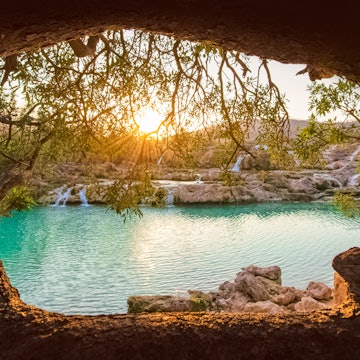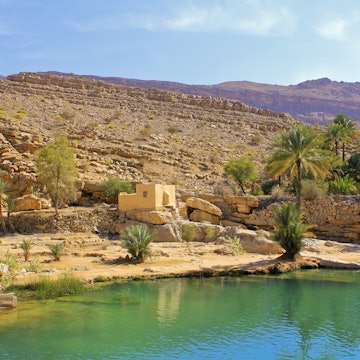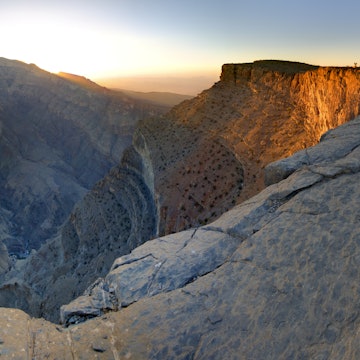
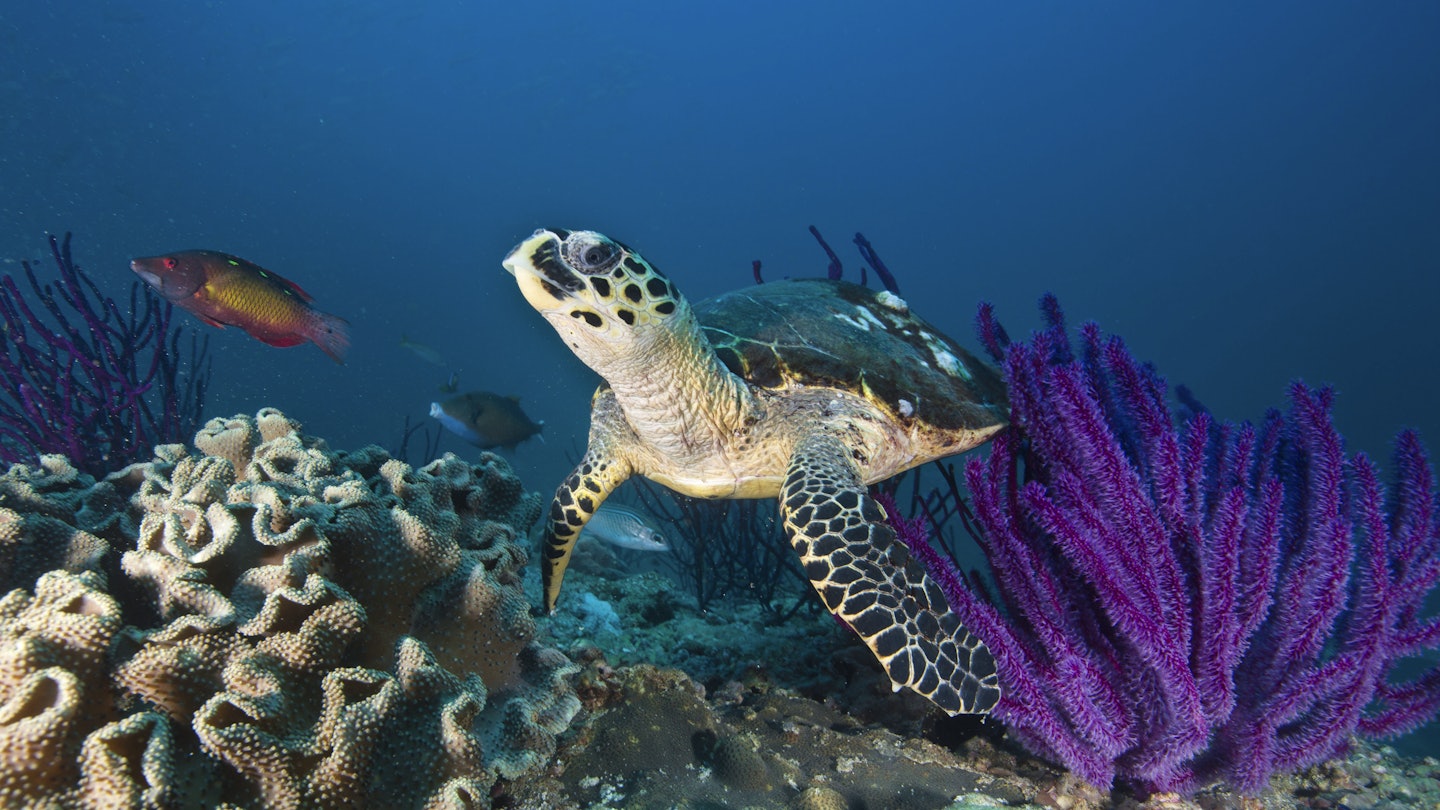
A hawksbill sea turtle paddles through purple whip coral. Liquid_Light / Getty Images
With more than 2000km of coastline, Oman is a spectacular dive destination with many of the same species of coral and marine life as the Red Sea, but a fraction of the visitors.
What lures scuba divers to Oman’s underwater world is the greatest diversity of marine species in the Arabian Sea, which includes schools of mobula rays, 22 species of whales and dolphins and a rainbow of soft corals home to thousands of reef fish. Dive below the surface to discover these six sites where you can swim amongst unspoiled underwater oases.
Daymaniyat Islands: best for hawksbill sea turtles
The Daymaniyat Islands are the jewel of diving in Oman. The islands are the world’s densest nesting ground for hawksbill sea turtles, and this, coupled with the islands’ pristine coral gardens, astounding coral walls and the abundance of marine life put Oman on the diving world’s radar. The archipelago of nine rocky islands accessible from Muscat was designated the first marine reserve in Oman. The nutrient-rich waters attract abundant marine life to the area, and it’s even possible to dive alongside whale sharks during the cooler months. It’s an excellent dive site for all experience levels and even snorkellers. Note that the Daymaniyat Islands are closed from May to October annually to protect them.

Al Fahal Island: best for mobula rays and sharks
A limestone rock that was part of the seafloor millions of years ago, Al Fahal Island was uncovered by the changing sea levels, much to divers’ delight. The schools of black tip reef sharks that love the shallow sandbanks around Al Fahal, located just 4km off Muscat’s Al Qurum Beach, earn the island its nickname of Shark Island. It’s a dive location that’s like jumping in to an aquarium. All 39 varieties of coral that have been found in Oman occur here, making it one of the most beautiful reefs to dive in the country. Schools of barracuda swim overhead, giant eagle rays glide past and large groups of mobula rays perform underwater acrobatics. All dive experience levels can enjoy this site, and regular divers to Oman don’t hesitate to name it their favourite.
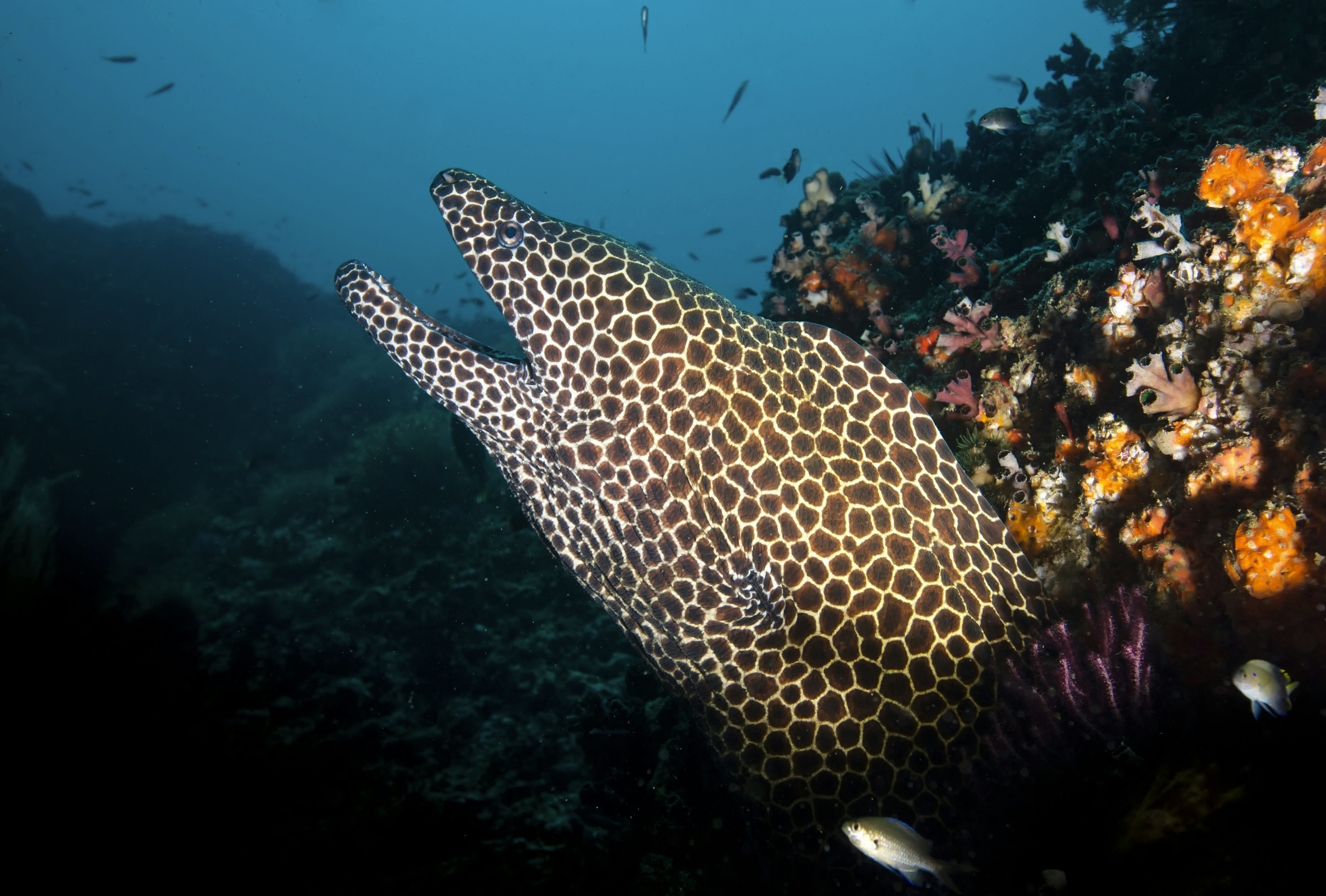
Bandar Khayran: best for honeycomb moray eels
Bandar Khayran is dramatic both above and below the sea, with several different dive sites located all relatively close together in a series of stunning sheltered white sand bays and deserted coves only accessible by boat 25km southeast of Muscat. Massive honeycomb moray eels, one of the largest species, protrude from the many holes and caves in and around the corals. Bandar Khayran is predominantly shallow coral reefs with an average depth of 15m, making it excellent for all divers, and it’s a common site for divers completing open water certifications.

Al Munnassir: best for nudibranches
Al Munnassir is a 3000-tonne English trooper wreck that was purposely sunk by the Royal Navy of Oman in 2003 off the coast of Muscat to create an artificial reef. It’s 84m long and 14.5m wide, and has slowly developed in to a fascinating dive site. Although a relatively new reef, it’s already smothered in corals and teeming with marine life. Divers love this site for hunting for nudibranches, a tiny, colourful type of slow-moving shell-less sea slug, and it's also exceptional for spotting seahorses and soft corals. An advanced open water certification is required to dive Al Munnassir.

Turtle City: best for beginner divers
Oman is home to five of the world’s seven sea turtle species, and at Turtle City, the dive site adjacent to Al Munnassir along the rock falls and sea walls, green turtles and hawksbills are plentiful. It’s common even to spot the curious turtles coming to the surface before diving in. This dive site is suitable for any dive certification level, and it’s particularly perfect for beginner divers because of the its position in a calm, sheltered cove.
Mirbat: best for big dolphins and whales
Head 1000km south of Muscat to Mirbat in Oman’s Dhofar Governorate, and it’s as though you’ve arrived in an entirely different country, both above and below the sea. While the Daymaniyat Islands and Muscat are a coral reef haven, Mirbat is a playground for 22 species of dolphins and whales.
The Dhofar Governorate is a complete contrast to the rest of Oman. The annual khareef, or summer monsoon season, turns the dry desert landscape into a lush green oasis with gushing waterfalls suddenly pouring out of the mountains. There’s a transformation beneath the surface too, as the monsoon brings cold swells and dramatic underwater temperature drops. Mirbat is one of the only places in the world where you can see both corals and kelp forests.
In the waters of Mirbat divers can often dive right alongside dolphins and humpback whales. Starfish, cuttlefish and giant nudibranches are common. The dive centres in Mirbat close from May through September, when the waters become too rough from the conditions created by the khareef. Take care even toward the end of the dive season, as the water and swells can be extremely rough. Because of low visibility, big marine animals and rough seas, Mirbat is best for divers with a fair amount of dives in their log books.
Tips for organising a diving trip in Oman
Diving in Oman is best from October through May when the seas are warm and calm. Each dive sites varies greatly, but generally expect 5-30m visibility and water temperatures of 19-28°C.
Whale shark season is from September through October.
It’s best to book the first dive trip of the day for the most favorable conditions.
There are several dive centres in Oman, with the majority located around Muscat. There are excellent resorts with on-site dive centres such as Shangri-La Barr Al Jissah Resort & Spa, with Extra Divers Qantab located in their Shangri-La Marina. Extra Divers Mirbat are the diving experts in the Dhofar Governorate. The world-known liveaboard Aggressor also added Oman to their destinations in 2017.
Don’t be afraid to ask questions when choosing a dive centre. A good outfit will be happy to communicate with you in advance of your trip, answer all your questions about their equipment, certifications and services offered. If they don’t have time for you before you arrive, it’s a pretty good indication of how you’ll be treated throughout the entire dive experience.
Ask whether towels are provided and if there is drinking water on board the dive boat.
Full equipment rental is available from many dive centres, though having and packing a few basic pieces of your own equipment like a mask and wetsuit can make your dive much more comfortable.





